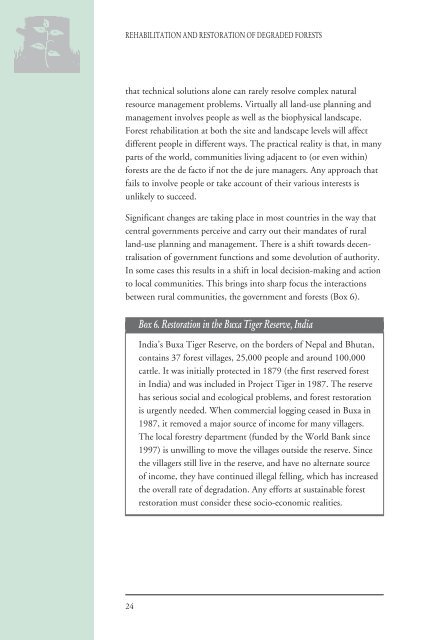Rehabilitation and Restoration Of Degraded Forests (PDF) - IUCN
Rehabilitation and Restoration Of Degraded Forests (PDF) - IUCN
Rehabilitation and Restoration Of Degraded Forests (PDF) - IUCN
You also want an ePaper? Increase the reach of your titles
YUMPU automatically turns print PDFs into web optimized ePapers that Google loves.
REHABILITATION AND RESTORATION OF DEGRADED FORESTS<br />
that technical solutions alone can rarely resolve complex natural<br />
resource management problems. Virtually all l<strong>and</strong>-use planning <strong>and</strong><br />
management involves people as well as the biophysical l<strong>and</strong>scape.<br />
Forest rehabilitation at both the site <strong>and</strong> l<strong>and</strong>scape levels will affect<br />
different people in different ways. The practical reality is that, in many<br />
parts of the world, communities living adjacent to (or even within)<br />
forests are the de facto if not the de jure managers. Any approach that<br />
fails to involve people or take account of their various interests is<br />
unlikely to succeed.<br />
Significant changes are taking place in most countries in the way that<br />
central governments perceive <strong>and</strong> carry out their m<strong>and</strong>ates of rural<br />
l<strong>and</strong>-use planning <strong>and</strong> management. There is a shift towards decentralisation<br />
of government functions <strong>and</strong> some devolution of authority.<br />
In some cases this results in a shift in local decision-making <strong>and</strong> action<br />
to local communities. This brings into sharp focus the interactions<br />
between rural communities, the government <strong>and</strong> forests (Box 6).<br />
24<br />
Box 6. <strong>Restoration</strong> in the Buxa Tiger Reserve, India<br />
India’s Buxa Tiger Reserve, on the borders of Nepal <strong>and</strong> Bhutan,<br />
contains 37 forest villages, 25,000 people <strong>and</strong> around 100,000<br />
cattle. It was initially protected in 1879 (the first reserved forest<br />
in India) <strong>and</strong> was included in Project Tiger in 1987. The reserve<br />
has serious social <strong>and</strong> ecological problems, <strong>and</strong> forest restoration<br />
is urgently needed. When commercial logging ceased in Buxa in<br />
1987, it removed a major source of income for many villagers.<br />
The local forestry department (funded by the World Bank since<br />
1997) is unwilling to move the villages outside the reserve. Since<br />
the villagers still live in the reserve, <strong>and</strong> have no alternate source<br />
of income, they have continued illegal felling, which has increased<br />
the overall rate of degradation. Any efforts at sustainable forest<br />
restoration must consider these socio-economic realities.

















